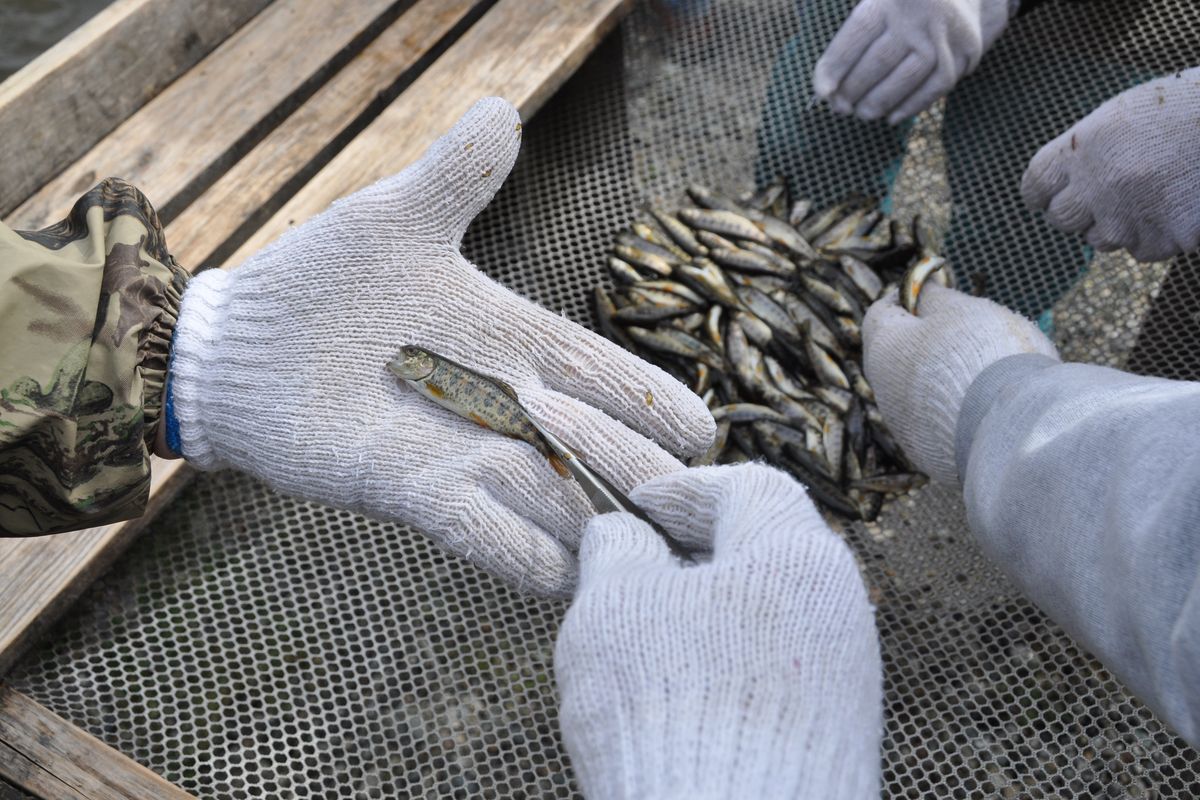Wash. anglers reaping benefits from fin-clipped trout, salmon

However, selective removal of this fleshy protuberance on the fish’s back is paying big dividends for Washington anglers.
Fin-clipping hatchery-raised fish allows anglers to quickly distinguish protected wild fish that must be released alive. Endangered species rules would prohibit many fisheries where anglers couldn’t tell the difference between wild and hatchery fish.
In Eastern Washington, some trout are being fin-clipped by Fish and Wildlife Department fish managers in various studies. One at Curlew Lake will help save fishing license fee money at the hatcheries by determining how big they need to raise the trout before release in order to get the best cost-benefit ratio.
Two dozen volunteers from Spokane fly fishing clubs rose to the call this week as though it were another catch and release fishing trip. Their challenge: Use surgical scissors to clip the adipose fins off 60,000 trout fry in two days.
That means each angler handled about 2,500 trout – not a bad two days of fishing, even if the rainbows were only 3 inches long.
“These fry are going to the net pens at Curlew Lake,” said Ace Trump, Spokane Hatchery manager, noting that three different sizes of rainbows will be stocked in the lake this year.
It’s cheaper to raise fish to 3 inches before leaving the hatchery than it is to raise them weeks longer to 5 inches or larger. But the cost might be justified if larger fry are better at surviving to the catchable sizes for anglers, he said.
Hatchery workers scooped nets full of the fry from hatchery ponds and soaked them briefly in anesthetic solution that briefly calms the fish so they can be handled, clipped and returned to the water in another pond.
The job is bigger at Lake Roosevelt, where 750,000 hatchery rainbows are fin-clipped before being stocked in net pens for rearing and release each year.
That project has helped biologists determine that roughly 20 percent of the rainbows Roosevelt anglers catch are wild fish, said John Whalen, WDFW regional fisheries manager. The information can be used improve wild fish survival and production.
But even the Lake Roosevelt trout project pales in comparison to the mass marking of salmon and steelhead.
In 2009, 16.6 million coho, 55.1 million chinook and 77.9 million steelhead were fin-clipped in the Columbia River, Washington Coast and Puget Sound hatchery programs.
All fin-clipping – biologists refer to it as ‘marking,’ – was done by hand until the past few years, when the state acquired several machines. Operated by as few as three people, they can fin-clip 7,000 fingerlings an hour – that’s two fish a second.
Adipose fin clipping was first used by researchers to mark the fish with coded wire tags inserted in their snouts, said Lee Blankenship, a retired Fish and Wildlife Department researcher.
Blankenship works for Northwest Marine Technology, which manufactures the tags that are inserted in about 50 million salmon and steelhead a year from California to Alaska to study fish migration patterns.
Once scanners were developed to detect which fish have been tagged without cutting into the fish’s head, clipping adipose fins could be used solely to distinguish between wild and hatchery fish.
“Marking has opened salmon fisheries that had been closed down,” said Tony Floor, another former WDFW salmon program staffer who works for the Northwest Marine Trade Association.
Fin-clipping was a controversial proposal when endangered species protections loomed for certain declining wild salmon and steelhead stocks in the 1980s, Floor said.
Recreational fishing seasons were curtailed along the coast closed in northern Puget Sound and the Strait of Juan de Fuca because anglers couldn’t distinguish the endangered wild fish from the fish that originated at hatcheries. Fishing charters, stores and resorts were going out of business.
But commercial fishermen and Indian tribes opposed fish marking because it could lead to more restrictions on use of gillnets, which don’t allow caught fish to be released if they are identified as wild.
“Marking fish would put the conservation spotlight on them to protect wild fish, setting up the collision of treaty rights and the Endangered Species Act,” Floor said.
The Washington Legislature was finally persuaded to require fish marking in the mid-1990s. Crews started clipping the adipose fins of hatchery coho in 1996, and hatchery chinook in 1999.
The result: Significant coho selective fisheries were once again allowed in 1999 from juveniles clipped in 1997. These selective fisheries have gradually expanded.
Last year the first coastal chinook selective fishery was authorized to provide an additional fishery that had been curtailed for more than a decade.
“California is where we were years ago, with closed ocean seasons because of constraints on certain weak stocks of fish,” Floor said. “Because they haven’t started fin clipping, they sit on the beach while we go fishing.
“This is the fifth year we’ve been able to move forward and reopen summer selective salmon fisheries out of Sekiu, Port Angeles, Port Townsend and Everett. That translates into about 100,000 angler trips from the middle of July through August – an opportunity we didn’t even have five years ago.”